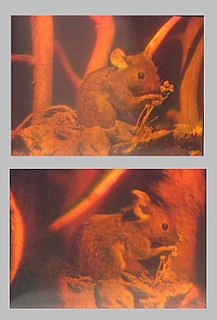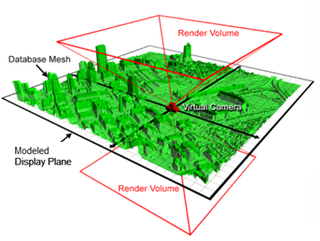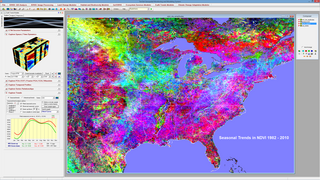
Links is an open source text and graphic web browser with a pull-down menu system. It renders complex pages, has partial HTML 4.0 support, supports color and monochrome terminals and allows horizontal scrolling.

Holography is the science and practice of making holograms. A hologram, also known as a holograph, is a real world recording of an interference pattern which uses diffraction to reproduce a 3D light field, resulting in an image which still has the depth, parallax, and other properties of the original scene. A hologram is a photographic recording of a light field, rather than an image formed by a lens. The holographic medium, for example the object produced by a holographic process is usually unintelligible when viewed under diffuse ambient light. It is an encoding of the light field as an interference pattern of variations in the opacity, density, or surface profile of the photographic medium. When suitably lit, the interference pattern diffracts the light into an accurate reproduction of the original light field, and the objects that were in it exhibit visual depth cues such as parallax and perspective that change realistically with the different angles of viewing. That is, the view of the image from different angles represents the subject viewed from similar angles. In this sense, holograms do not have just the illusion of depth but are truly three-dimensional images.

Dennis Gabor was a Hungarian-British electrical engineer and physicist, most notable for inventing holography, for which he later received the 1971 Nobel Prize in Physics.

Stereoscopy is a technique for creating or enhancing the illusion of depth in an image by means of stereopsis for binocular vision. The word stereoscopy derives from Greek στερεός (stereos) 'firm, solid', and σκοπέω (skopeō) 'to look, to see'. Any stereoscopic image is called a stereogram. Originally, stereogram referred to a pair of stereo images which could be viewed using a stereoscope.

A spatial light modulator (SLM) is an object that imposes some form of spatially varying modulation on a beam of light. A simple example is an overhead projector transparency. Usually when the phrase SLM is used, it means that the transparency can be controlled by a computer. In the 1980s, large SLMs were placed on overhead projectors to project computer monitor contents to the screen. Since then more modern projectors have been developed where the SLM is built inside the projector. These are commonly used in meetings of all kinds for presentations.
The Atari Cosmos was an unreleased product by Atari, Inc. for the handheld/tabletop electronic game system market that uses holography to improve the display. It is similar to other small electronic games of the era that used a simple LED-based display, but superimposes a two-layer holographic image over the LEDs for effect. Two small lights illuminate one or both of the holographic images depending on the game state. The system was never released, and is now a coveted collectors item.
Holonomic brain theory, also known as The Holographic Brain, is a branch of neuroscience investigating the idea that human consciousness is formed by quantum effects in or between brain cells. This is opposed by traditional neuroscience, which investigates the brain's behavior by looking at patterns of neurons and the surrounding chemistry, and which assumes that any quantum effects will not be significant at this scale. The entire field of quantum consciousness is often criticized as pseudoscience, as detailed on the main article thereof.

A hogel is a part of a light-field hologram, in particular a computer-generated one. It is considered a small holographic optical element or HOE and that its total effect to that of a standard hologram only that the resolution is lower and it involves a pixelated structure. An array of these elements form the complete image of a holographic recording, which is typically displayed in 3D free-viewing device.
Screenless video is any system for transmitting visual information from a video source without the use of a screen. Screenless computing systems can be divided into three groups: Visual Image, Retinal Direct, and Synaptic Interface.
Computer-generated holography (CGH) is the method of digitally generating holographic interference patterns. A holographic image can be generated e.g. by digitally computing a holographic interference pattern and printing it onto a mask or film for subsequent illumination by suitable coherent light source.

Stephen Anthony Benton was the E. Rudge ('48) and Nancy Allen Professor of Media & Sciences, and the Director for Center for Advanced Visual Studies (CAVS) at Massachusetts Institute of Technology. He was the inventor of the rainbow hologram and a pioneer in medical imaging and fine arts holography. Benton held 14 patents in optical physics and photography, and taught media arts and sciences at MIT.

TerrSet is an integrated geographic information system (GIS) and remote sensing software developed by Clark Labs at Clark University for the analysis and display of digital geospatial information. TerrSet is a PC grid-based system that offers tools for researchers and scientists engaged in analyzing earth system dynamics for effective and responsible decision making for environmental management, sustainable resource development and equitable resource allocation.

Australian Holographics was started with the specific objective to produce high quality large format holograms. After two years of research and development the company began commercial operations in 1991.
A holographic display is a type of display that utilizes light diffraction to create a virtual three-dimensional image. Holographic displays are distinguished from other forms of 3D displays in that they do not require the aid of any special glasses or external equipment for a viewer to see the image.

Security holograms are labels with a hologram printed onto it for sale security reasons. Holograms on security labels are very difficult to forge because they are replicated from a master hologram which requires expensive, specialized and technologically advanced equipment. They are used widely in several banknotes around the world, in particular those that are of high denominations. They are also used in passports, credit and bank cards as well as quality products. Herman Lopata, the President of the New York-based Automatic Toll Systems, Inc., received a patent in 1987 for the credit card security hologram as part of his early work on high speed highway toll collection—the predecessor of the modern EZ Pass type equipment.

Zebra Imaging was a company that developed 3D digital holographic images, hologram imagers and interactive 3D displays for government and commercial uses. The company offers digital holograms that are autostereoscopic, full-parallax and in monochrome or full-color. They have also developed a 3D Dynamic Display, which is capable of rendering holograms in real time. To a layperson, this means that design work with 3D programs such as SketchUp and 123D Catch can be viewed on a holographic display while they are actively being edited.
Holographic optical element (HOE) is an optical component that produces holographic images using principles of diffraction. HOE is most commonly used in transparent displays, 3D imaging, and certain scanning technologies. The shape and structure of the HOE is dependent on the piece of hardware it is needed for, and the coupled wave theory is a common tool used to calculate the diffraction efficiency or grating volume that helps with the design of an HOE. Early concepts of the holographic optical element can be traced back to the mid 1900s, coinciding closely with the start of holography coined by Dennis Gabor. The application of 3D visualization and displays is ultimately the end goal of the HOE; however, the cost and complexity of the device has hindered the rapid development toward full 3D visualization. The HOE is also used in the development of augmented reality(AR) by companies such as Google with Google Glass or in research universities that look to utilize HOEs to create 3D imaging without the use of eye-wear or head-wear. Furthermore, the ability of the HOE to allow for transparent displays have caught the attention of the US military in its development of better head-up displays (HUD) which is used to display crucial information for aircraft pilots.
Holography is often used as a plot device in science fiction, appearing in a wide range of books, films, television series, animation and video games. Probably the first reference is by Isaac Asimov in his sci-fi novel series “the Foundation Trilogy” in 1951.

Holographic Studios, located in the borough of Manhattan in New York City, is the world's oldest gallery of holography. It was founded in 1979 by Jason Sapan, one of the pioneers of holography. The storefront level gallery features the world's largest collection of motion image integral holograms. On display in the gallery are a variety of different types of holographic images, including a collection of celebrity hologram portraits. There are also cylindrical 360° floating images, multiple image holograms that change as you walk by, and computer generated holograms as well as a selection of novelty hologram items and stickers. Directly below the gallery is the laser laboratory where holograms are created. Holographic Studios creates custom holograms, holographic portraits, offers classes, and operates tours.
The Harvard Laboratory for Computer Graphics and Spatial Analysis pioneered early cartographic and architectural computer applications that led to integrated geographic information systems (GIS). Some of the Laboratory's influential programs included SYMAP, SYMVU, GRID, CALFORM, and POLYVRT. The Laboratory's Odyssey project created a geographic information system that served as a milestone in the development of integrated mapping systems. The Laboratory influenced numerous computer graphic, mapping and architectural systems such as Intergraph, Computervision, and Esri.











